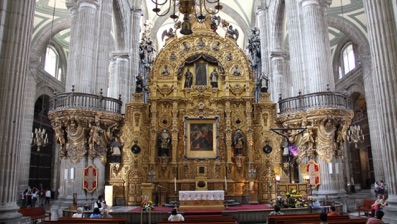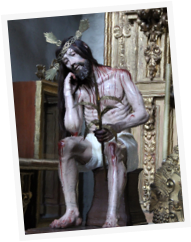If I haven’t said it yet, a good guidebook is worth its weight in gold. The confidence gained by knowing minute details of certain situations, before you’re in them, makes traveling a much nicer affair. We learned long ago to be happy and spend the $12-15 on a good guidebook, reading it closely before your feet land on foreign soil. Moon and Rough Guides, or Rick Steves’ if he makes a book for your destination, rarely let us down.
I say this because the guidebook we purchased before leaving was good enough to give specific directions for riding the subway to the major bus terminal in the north of the city, and to tell us where to buy tickets to travel to the pyramids of Teotihuacan, 50 kilometers north of the city.
This society was long gone when the Aztecs rose to power, so not much is known of them. What is known is that these pyramids weren’t built as final resting places, as with their Egyptian counterparts. Rather, they were lived upon and ceremonies were performed on them.
When the Aztecs entered the Valley of Mexico, they found these ruins and believed this to be the place were the gods were born. Teotihuacan means just that in the Aztec tongue.
We arrived practically as the gates were opening and we spent an unfettered couple of hours climbing up and down these man-made mountains.
A study of world history often reveals that the elites of many cultures use buildings to overwhelm and, in short order, oppress certain groups of people. In two days we had visited three buildings that accomplished this: the Metropolitano Catedral, the Templo Mayor, and these behemoths at Teotihuacan.
Each structure was designed to make the observer stagger a few steps when viewed for the first time, and wonder who, or what, was powerful enough to construct such a fabulous monstrosity? Surely no ordinary human could do this? Any person, or persons, that could do this must be more powerful than you or me. We better listen to them!
Around 11 a.m. we we’d had our fill and walked back to the gate to await our ride. Fifteen minutes later, we were aboard a very nice bus, barreling back towards the Cuidad de Mexico.
An hour we were in the Terminal de Autobuses del Norte, walking towards the metro stop. Another 45 minutes would see us back in the Zocalo.
Unfortunately, until this point, we were unable to give the Catedral Metropolitano a good viewing, be it from the weekend crowds or mass being conducted all day Sunday.
First, let me say, this place is stunning. And while, I’m at it, let me give every synonym the thesaurus gives for stunning: astonishing, amazing, astounding, extraordinary, incredible, unbelievable, marvelous, wonderful, wondrous, fabulous, miraculous, sensational, startling, shocking, staggering, jolting, jarring, overwhelming, overpowering, and mind-blowing.
I like to imagine myself as an Aztec peasant, in the 17th Century, making my way to Mexico City, and entering this building. My first sight would be the Altar of Forgiveness. The name, it’s said, was given because victims of the Spanish Inquisition were brought to this altar as their final place to ask for forgiveness before meeting the executioner.
As grisly as that story is, my Aztec notions while looking upon this golden monument wouldn’t care. The sight would be staggering and awe-inspiring. My world view would change.
As I walk down the nave, the chapels, each impressive in their own right, along the walls are numerous. Each is dedicated to a different event or person. To my left, the organ pipes come into view, a sight as foreign to me as the boats the Spanish arrived on, a hundred years ago.
Another interesting fact is the nave seems to be twisting, with the rear being at an angle to the front. Unfortunately, the Spanish weren’t as crafty as the Aztec, and, instead of building their temple from lightweight volcanic rock like our temples were built from, they used heavier materials. As such, their temples are now sinking into the soft lakebed that Mexico City is built upon.
The Spanish quickly realized their great creation was shifting rather rapidly. They strung this bob to measure just how fast this shift was occurring. Because of this, a timeline of the dome’s vertical progress has been imprinted on the central tile of the church, beginning in 1573.
By the 1980’s, leaning was to a point that the church was in danger of collapsing. A massive project to straighten and anchor the church was undertaken. Today, the church isn’t back to original, but it isn’t in danger of collapse either.
Once again, my concepts of reality are bending. Any society that could produce this work isn’t a society to resist. It would be better to merge. It’s obvious the Aztec’s day is done.




































